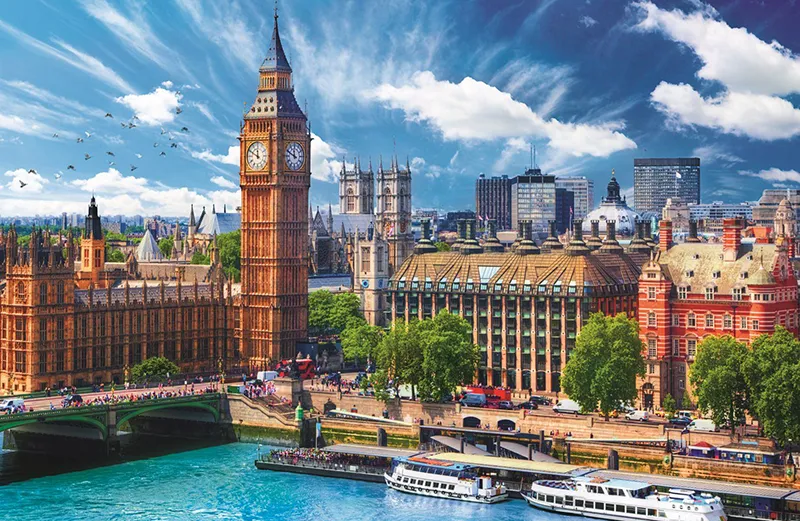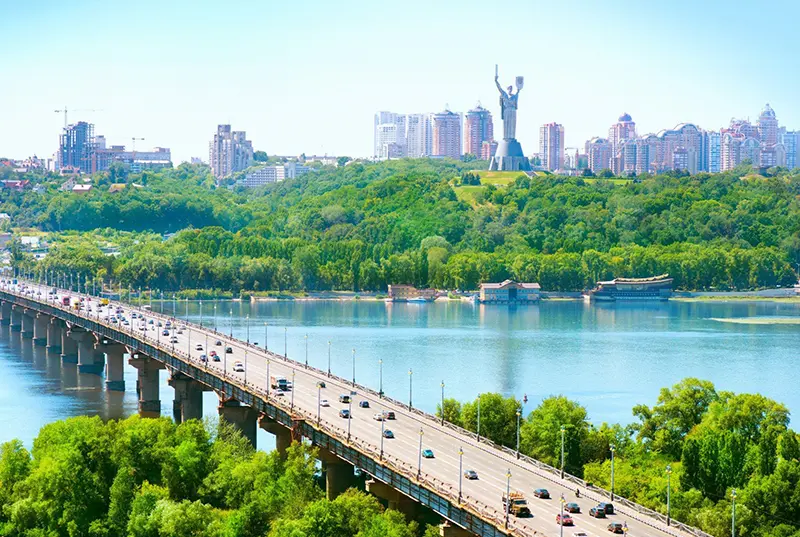The capital of the United Kingdom
London, the capital of the United Kingdom of Great Britain and Northern Ireland, is located in the south-eastern part of England, on both banks of the Thames River, 80 km from its confluence with the North Sea. It stands directly on the zero meridian, or, as it is called, Greenwich meridian.
At the end of XIV century London was already a huge city with 40 thousand people. Thanks to British occupation policy London became the capital of the largest colonial power in the world, and in 1842 it already had 2,200,000 inhabitants. Today it has a population of over 7,500,000, and if you count the residents of the suburbs, the figure exceeds 12,000,000. Living in this urban wonder is not easy with so many people moving through the streets that it is hard to get through; the cars of the world’s oldest subway are overcrowded. The standard of living and housing prices in London is among the highest in Europe.
The City of London (historic city center) is home to the main attractions: St. Paul’s Cathedral and the Tower of London, built in the 11th century. William the Conqueror as a fortress. The Tower was the residence of British kings, later turned into a prison, and now it is a historical museum with a magnificent collection of weapons, all kinds of torture devices and royal regalia.
The West End is the city’s aristocratic quarter and a hub of theatrical and concert life. From the Royal Covent Garden Theatre, the Criterion Theatre in Piccadilly Square and the nightclubs and hotspots of Soho, to the most expensive stores, hotels, cinemas and fashionable restaurants, the West End is buzzing with activity night and day. It is also home to Trafalgar Square, the largest traditional meeting place in the city and surrounded by the Royal Parks: Regent’s Park to the northwest, Kensington Gardens and Hyde Park to the southwest, Green Park to the south. London’s richest people live in their vicinity. Hyde Park is known outside Britain for being not only a great place for swimming, but also a great “podium” for eloquence exercises. Here is the famous Speakers’ Comer, where almost anyone can speak, though without a microphone. It’s not for nothing that Hyde Park has become synonymous with freedom of speech. In the southern part of the West End, in the district of Westminster, is the Palace of Westminster, where the British Parliament meets. One of the palace towers is home to what Londoners call Big Ben. Nearby is Westminster Abbey, the traditional coronation and burial place of English kings.
The antipode of the West End is the East End, a proletarian, port district. Beyond Greater London stretches the industrial and residential suburbs.
Speaking of London, we can mean three different cities: Authentic London, that is, a small City (2.6 km2), in which not more than 8600 people live, but where every day comes to work 350 thousand, Greater London (1579 km2, more than 7 million people) and, finally, urban agglomeration (over 12 million people).
The City of London is equally a city of businessmen, officials and tourists. The area is not considered a residential zone: only about 8,600 people live here. The majority of London’s population is concentrated outside the city and on its periphery.
History
The city was founded in 43 AD by the Romans and was named Londinium. There are several popular versions about the etymology of the word. Two of them are of Latin origin, either from a Roman personal name meaning “fierce”, or from the word lond, which is translated as “wild place”.
There is also a Celtic variant, suggesting a combination of two words – Uin (lake) and Dun (fortification), because it is believed that the Romans did not come to an empty (wild) place, but settled in a Celtic settlement. They built a pier and fenced off the area of the city (now the City) with a protective wall (its remains can be seen near the subway station Tower Hill).
For two millennia, London has been the nation’s capital, and the seat of government. Here sits the government, parliament and the judiciary, and here is the residence of the Queen. But above all London is one of the largest financial and commercial centers in Europe and the world. In the small City of London, nicknamed “the square mile” by Londoners for its modest size, there is the London Stock Exchange and the headquarters of Britain’s largest banks, insurance companies, commodity and financial exchanges, wholesale trading centers, the boards of the world’s largest corporations and luxury hotels. The prices of these hotels are among the highest in the world.
But London belongs to more than just white-collar workers. A large part of the city’s population is made up of immigrants from all over the world, who make a special contribution to the characteristic atmosphere of London. Tourists visiting the capital of the United Kingdom can’t help but feel this interesting mix of different cultures, cuisines and dialects. The 2001 census showed that 27% of Londoners were born outside the European Union. Only 71% of the city’s population is Caucasian. The rest come from Africa, the Middle East, South Asia (Chinese, Filipinos, Japanese, Vietnamese), etc. And that’s not counting the many tourists from all corners of the world. This, however, does not prevent Londoners to cherish its centuries-old traditions.
General information
- The capital of the United Kingdom of Great Britain and Northern Ireland.
- One of the most important ports of the United Kingdom.
- Religion: Christianity (Anglicanism, Catholicism) – 58,2%, Islam, Hinduism, Judaism. Atheists amount to 15,8%.
- The most important city districts are: the City, Westminster, Soho, Chelsea, Kensington, Greenwich.
- River: Thames.
- Airports: Heathrow (the busiest in the world), Gatwick, Stansted.
- Area: 1706.8 km2.
- Population: 7,556,900 (2007), with more than 12,300,000 people in the metropolitan area.
- Population density: 4,427.5 people/km2.
Economy
- The largest global financial center: banking, insurance, asset management.
- Media (headquarters of BBC).
- The industry: electronic, mechanical engineering, power industry, petroleum, food-processing, footwear, clothing, pharmaceuticals.
- Tourism.
Climate and weather
- Moderate, damp climate.
- Average temperature in January is +2 ºС to +8 ºС. The average temperature in July is +14 ºС to +23 ºС.
Attractions
- National Gallery
- Tate Gallery
- British Museum
- Buckingham Palace
- Palace of Westminster (Houses of Parliament)
- Tower Bridge
- Tower of London
- Parks, Docks, Squares, Bars, Clubs, Galleries
Fun Facts
- As a result of Nazi bombing during World War II, about 30,000 residents of London were killed. Even Buckingham Palace – the royal residence – was affected.
- One fifth of London’s population died during the Great Plague of 1665. A year later another catastrophe happened – the Great Fire of London that destroyed 60% of buildings, including 87 churches.




